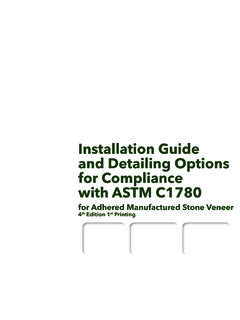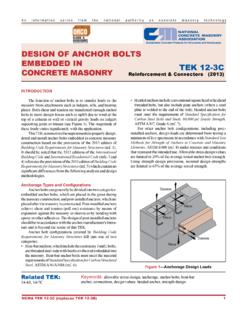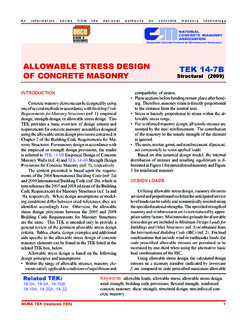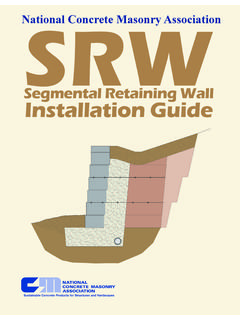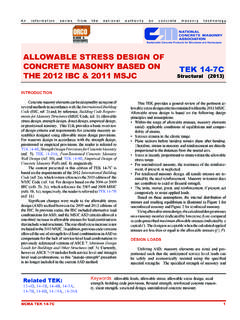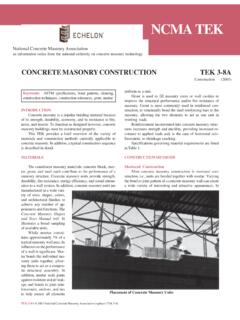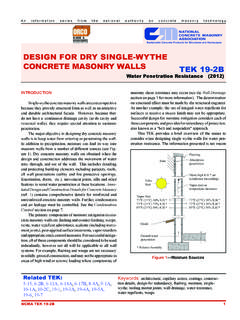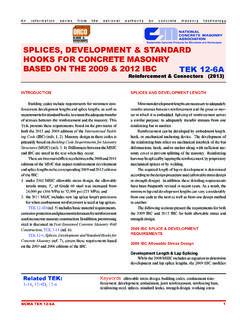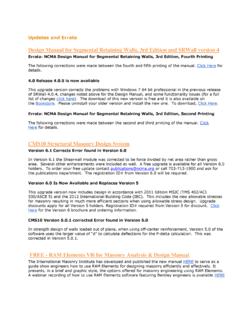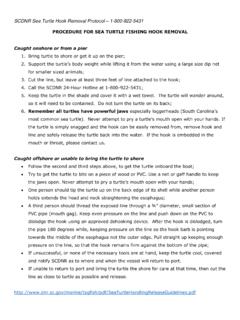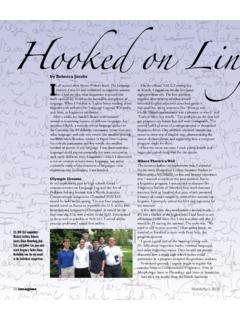Transcription of SPLICES, DEVELOPMENT AND STANDARD HOOKS …
1 An information series from the national authority on concrete masonry technologyNCMA TEK 12-6 1 splices , DEVELOPMENT AND STANDARD HOOKS FOR CONCRETE MASONRYTEK 12-6 Reinforcement & Connectors (2007)INTRODUCTION Building codes include requirements for minimum rein-forcement DEVELOPMENT lengths and splice lengths, as well as requirements for STANDARD HOOKS , to ensure the adequate transfer of stresses between the reinforcement and the masonry. This TEK presents these requirements, based on the provisions of both the 2003 and 2006 editions of the International Building Code (IBC) (refs. 1, 2). TEK 12-4D (ref. 3) includes basic material requirements, corrosion protection and placement toler-ances for reinforcement used in concrete masonry construction.
2 In addition, prestressing steel is discussed in Post-Tensioned Concrete Masonry Wall Construction, TEK 3-14 (ref. 4). splices AND DEVELOPMENT Minimum DEVELOPMENT lengths are necessary to adequately transfer stresses between reinforcement and the grout or mor-tar in which it is embedded. Splicing of reinforcement serves a similar purpose; to adequately transfer stresses from one reinforcing bar to another. Reinforcement can be developed by embedment length, hook, or mechanical anchoring device. The DEVELOPMENT of the reinforcing bars relies on mechanical interlock of the bar deformations, hook, and/or anchor along with sufficient ma-sonry cover to prevent splitting of the masonry.
3 Reinforcing bars may be spliced by lapping the reinforcement, by proprietary mechanical splices or by welding. The required length of lap or DEVELOPMENT is determined according to the design procedure used and type of detail em-ployed. In addition, these detailing requirements have been frequently revised in recent years. As a result, the minimum lap and DEVELOPMENT lengths can vary considerably from one code to the next as well as from one design method to another. For this reason, the following sections present the requirements for both the 2003 IBC and 2006 IBC for both allowable stress and strength design. Because the detailing requirements for these two codes can be significantly different, designers using Related TEK:Keywords: allowable stress, DEVELOPMENT , embedment, joint reinforce-ment, reinforcing bars, reinforcing steel, splices , STANDARD HOOKS , strength design, working stressthe 2003 IBC are encouraged to compare these requirements to the corresponding 2006 IBC STRESS DESIGN2003 IBC Allowable Stress Design By reference to the 2002 edition of Building Code Re-quirements for Masonry Structures (MSJC) (ref.)
4 5), the 2003 IBC requires the minimum DEVELOPMENT length for reinforcing bars and wires designed by the allowable stress method to be calculated using Equation 1 (see Tables 1 and 2). ld = Fs, (Eqn. 1) but not less than 12 in. (305 mm) for bars or 6 in. (152 mm) for wires. When epoxy coated bars or wires are used, the DEVELOPMENT length determined by Equation 1 is required to be increased by 50 percent. Although DEVELOPMENT lengths and lap splice lengths have historically been assumed to be related and calculated in a similar manner, the 2003 IBC provides a unique design equa-tion for determining the minimum length of lap for reinforcing bars, in accordance with Equation 2.
5 Table 5 contains tabulated values for common design variables shown in Equation 2. :''bybyddmmdfdfllKfKfgg == , (Eqn. 2) but not less than 15 in. (380 mm) For use in Equation 2, the reinforcement size factor, , is taken equal to for No. 3 through No. 5 (M#10 M#16) reinforcing bars; for No. 6 and No. 7 (M#19 and M#22) reinforcing bars; and for No. 8 and No. 9 (M#25 and M#29) reinforcing bars. Reinforcing bars larger than No. 9 (M#29) are required to be spliced using mechanical connectors. When noncontact lap splices are used, the bars must be spaced no farther apart than one-fifth the required length of lap nor more than 8 in. (203 mm). As an alternative to lap splicing, reinforcing bars can be spliced by welding.
6 Welded splices require the bars to be 2 NCMA TEK 12-6butted or shortly lapped and welded to develop in tension at least 125% of the specified yield strength of the bar. All weld-ing is required to conform to AWS D (ref. 6). In practice, however, welding tends to be an expensive splicing option. Finally, mechanical splicing of reinforcement typically employs proprietary couplers specifically designed for this application. Mechanical splices are required to have the bars connected to develop in tension or compression, as required, at least 125% of the specified yield strength of the bar. Reinforcing bars can also be spliced using end-bearing splices , but only in members containing closed ties, closed stirrups or spirals for bars subject to compression only.
7 End-bearing splices rely on the transmission of compressive stress by bearing of square cut ends held in concentric contact by a suitable device. The bar ends are required to terminate in flat surfaces within 11/2 degrees of a right angle to the axis of the bars and be fitted within 3 degrees of full bearing after IBC Allowable Stress Design With the publication of the 2006 IBC, which in turn refer-ences the 2005 MSJC (ref. 7), the majority of the splicing and DEVELOPMENT detailing requirements have remained the same, with the notable exception that Equation 2 has been superseded for determining the minimum length of lap splices . While the 2005 MSJC includes an equation to determine DEVELOPMENT length, which is also used to determine lap splice length, the 2006 IBC modifies the MSJC lap splice length.
8 In accordance with the 2006 IBC, the minimum required lap Table 2 2003 and 2006 IBC Allowable Stress Design DEVELOPMENT Lengths for Wires (refs. 1, 2) Minimum Wire size DEVELOPMENT lengthA, B, in. (mm) (11 gage, MW 7) 6 (152) (9 gage, MW 11) 7 (178) (8 gage, MW 13) 8 (203) (3/16 in., MW 17) 9 (229) (1/4 in., MW 32) 12 (305) A See Equation 1. Based on Fs = 30,000 psi (207 MPa) for wire joint reinforcement. DEVELOPMENT length not less than 6 in. (152 mm). B DEVELOPMENT lengths are to be increased by 50% when epoxy coated wire is 1 2003 IBC Allowable Stress Design DEVELOPMENT Lengths (ref. 1) Minimum Bar size DEVELOPMENT lengthA, B, in.
9 (mm) No. 3 (M#10) 14 (356) No. 4 (M#13) 18 (457) No. 5 (M#16) 23 (584) No. 6 (M#19) 27 (686) No. 7 (M#22) 32 (813) No. 8 (M#25) 36 (914) No. 9 (M#29) 41 (1,041) No. 10 (M#32) 46 (1,168) No. 11 (M#36) 51 (1,295)A See Equation 1. Based on Fs = 24,000 psi (165 MPa) for Grade 60 reinforcement. DEVELOPMENT length not less than 12 in. (305 mm). B DEVELOPMENT lengths are to be increased by 50% when epoxy coated reinforcement is 3 2006 IBC Allowable Stress Design DEVELOPMENT Lengths for Reinforcing Bars (ref. 2) Minimum DEVELOPMENT lengthA, in. (mm) based on: Bar in center of: K = 6-in. 8-in. 10-in. 12-in. 11/2 in. 2 in. Bar size (152-mm) CMU (203-mm) CMU (254-mm) CMU (305-mm) CMU (38 mm) (51 mm) No.
10 3 (M #10) 16 (406) B 16 (406) B 16 (406) B 16 (406) B 19 (483) 16 (406) B No. 4 (M#13) 21 (533) B 21 (533) B 21 (533) B 21 (533) B 34 (864) 26 (660) No. 5 (M#16) 32 (813) D 26 (660) B 26 (660) B 26 (660) B 53 (1,346) 40 (1,016) No. 6 (M#19) 61 (1,549) D 43 (1,092) 40 (1,016) B 40 (1,016) B 99 (2,515) 74 (1,880) No. 7 (M#22) NP C 60 (1,524) 46 (1,168) 46 (1,168) B 134 (3,404) 101 (2,565) No. 8 (M#25) NP C 92 (2,337) D 71 (1,803) 61 (1,549) B 202 (5,131) 151 (3,835) No. 9 (M#29) NP C NP C 91 (2,311) 74 (1,880) 257 (6,528) 193 (4,902) No. 10 (M#32) NP C NP C NP C 95 (2,413) 325 (8,255) 244 (6,198) No. 11 (M#36) NP C NP C NP C 118 (2,997) 401 (10,185) 301 (7,645) A See Equation 4.
